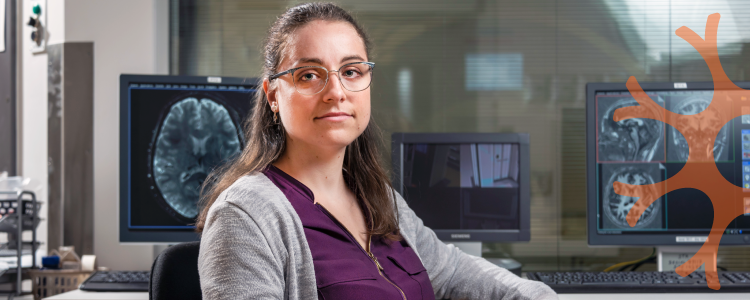

Justine Cléry, PhD, is an Assistant Professor at the Department of Neurology and Neurosurgery, Faculty of Medicine and Health Sciences at McGill University, and the head of the Sensory and Social Brain Mechanisms Lab at The Neuro.
She joined the Azrieli Centre for Autism Research (ACAR) in 2022.
What sparked your interest in working in the field of neurodevelopmental research?
Social cognition plays an important role in our everyday lives. After working in basic research for several years, I was eager to better understand the brain mechanisms linked to neurodevelopmental conditions.
On a more personal level, the son of my godmother was diagnosed with profound autism early in childhood, and is still very dependent on his family in adult life. I hope that my work helps to bring some clarity to the many ways in which social communication and interactions are present in autism.
What motivates your work?
I am motivated to contribute to advancing science through open collaboration and teamwork. This way, we can help to unravel the mystery of the brain, to make science more transparent and accessible, and ultimately to improve people's daily lives.
The development of sensory and social mechanisms in the brain is not yet fully understood. While we have data on behaviour, it is less clear how these functions are implemented in the brain and how they are established across our lives.
My research goal is to better understand how these sensory and social mechanisms evolve across a person's lifetime to help find and refine possible interventions that may improve quality of life for autistic people and their families.
I am driven to determine the best window during early life where we can apply these interventions. I conduct fMRI and behavioural tasks in marmosets across their lives, in both control and ASD models. I compare the functional network between these models to determine how they evolve with age and understand how they may be linked to the genes targeted in autism.
Why did you join ACAR?
ACAR is a great platform to foster strong collaborations.
As a member of ACAR, I take part of translational studies so that my fundamental research can be applied clinically to help patients, and conversely, so that clinical data can help refine and guide our research protocols and questions.
Biography
Justine Cléry, PhD, is a neuroscientist. Her research aims to better understand how sensory information and social cognition is encoded in the brain using functional magnetic resonance imaging (fMRI) in awake non-human primate models.
She is an Assistant Professor at the Department of Neurology and Neurosurgery, Faculty of Medicine and Health Sciences at McGill University, the head of the Sensory and Social Brain Mechanisms (SSBM) Lab at The Neuro, and research member of the Azrieli Centre for Autism Research (ACAR).
Justine obtained her Doctorate in Neurosciences at the University of Claude Bernard Lyon 1 in 2017, under the supervision of Dr. Suliann Ben Hamed, at the Institut des Sciences Cognitives, Lyon, France. From 2017 to 2021, she was a Postdoctoral Associate, working with Pr. Stefan Everling in the Laboratory for Neural Circuits and Cognitive Control at the Robarts Research Institute, University of Western Ontario, Canada.
Awards and Recognitions
- BrainsCAN Postdoctoral Fellowship Tier II (December 2017-March 2021)
- BrainsCAN Postdoctoral Fellowship Tier I (April 2021-March 2022)
- CIHR Postdoctoral Fellowship (June 2021-March 2022)
- Berthe-Fouassier Foundation Fellowship (September 2016-June 2017)
Research Areas
Functional Imaging (fMRI), social cognition, sensory processing, space representation, neurodevelopment
List of Selected Publications
Gilbert, K.M., Cléry, J.C., Gati, J.S., Hori, H., Johnston, K.D, Mashkovtsev, A., Selvanayagam, J., Zeman, P., Menon, R.S., Schaeffer, D.J., Everling, E. Simultaneous functional MRI of two awake marmosets. Nature Communications. https://doi.org/10.1038/s41467-021-26976-4
Cléry, J.C., Hori, H., Schaeffer, D.J., Menon, R.S., Everling, S. (2021) Social interaction observation network identified in marmosets by ultra-high field fMRI. eLife. https://doi.org/10.7554/eLife.65012
Cléry, J. C., Hori, Y., Schaeffer, D. J., Gati, J. S., Pruszynski, J. A., & Everling, S. (2020). Whole brain mapping of somatosensory responses in awake marmosets investigated with ultra-high field fMRI. Journal of Neurophysiology. https://doi.org/10.1152/jn.00480.2020
Cléry, J. C., Schaeffer, D. J., Hori, Y., Gilbert, K. M., Hayrynen, L. K., Gati, J. S., Menon, R. S., & Everling, S. (2020). Looming and receding visual networks in awake marmosets investigated with fMRI. NeuroImage, 215, 116815. https://doi.org/10.1016/j.neuroimage.2020.116815
Cléry, J., Guipponi, O., Odouard, S., Wardak, C., & Ben Hamed, S. (2018). Cortical networks for encoding near and far space in the non-human primate. NeuroImage, 176, 164–178. https://doi.org/10.1016/j.neuroimage.2018.04.036
Cléry, J., & Ben Hamed, S. (2018). Frontier of Self and Impact Prediction. Frontiers in Psychology, 9. https://doi.org/10.3389/fpsyg.2018.01073
Cléry, J., Amiez, C., Guipponi, O., Wardak, C., Procyk, E., & Ben Hamed, S. (2017). Reward activations and face fields in monkey cingulate motor areas. Journal of Neurophysiology, 119(3), 1037–1044. https://doi.org/10.1152/jn.00749.2017
Cléry, J., Guipponi, O., Odouard, S., Pinède, S., Wardak, C., & Hamed, S. B. (2017). The Prediction of Impact of a Looming Stimulus onto the Body Is Subserved by Multisensory Integration Mechanisms. Journal of Neuroscience, 37(44), 10656–10670. https://doi.org/10.1523/JNEUROSCI.0610-17.2017
Cléry, J., Guipponi, O., Wardak, C., & Ben Hamed, S. (2015). Neuronal bases of peripersonal and extrapersonal spaces, their plasticity and their dynamics: Knowns and unknowns. Neuropsychologia, 70, 313–326. https://doi.org/10.1016/j.neuropsychologia.2014.10.022
Cléry, J., Guipponi, O., Odouard, S., Wardak, C., & Ben Hamed, S. (2015). Impact prediction by looming visual stimuli enhances tactile detection. The Journal of Neuroscience: The Official Journal of the Society for Neuroscience, 35(10), 4179–4189. https://doi.org/10.1523/JNEUROSCI.3031-14.2015
Link(s)





